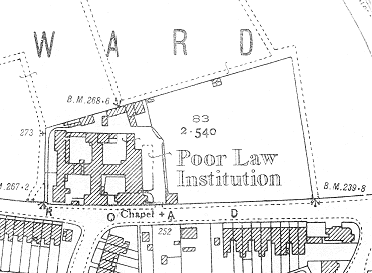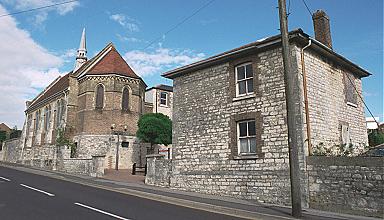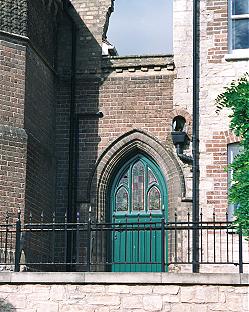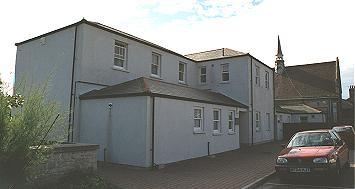Dorchester, Dorset
Up to 1834
The earliest workhouse in Dorchester dates back as far as 1616 with the setting up of the "Hospital of the Bailiffs and Burgesses of the Borough of Dorchester". Situated at the lower end of South Street and South Back Street, the workhouse was to house 50 poor children and apprentice them to "some lawful trade, mystery, or manual occupation." The building was demolished in 1836.
A parliamentary report of 1777 recorded parish workhouses in operation at Dorchester—Holy Trinity (for up to 80 inmates), Fordington (20), Frampton (12), and Puddletown (20).
Charminster had a parish poorhouse in operation in the 1830s. It was located immediately to the west of the churchyard at what is now 1 West Hill. The property was sold off in 1838 to a vet in Dorchester.
After 1834
Dorchester Poor Law Union was formed on 2nd of January 1836. Its operation was overseen by an elected Board of Guardians, 43 in number, representing its 39 constituent parishes as listed below (figures in brackets indicate numbers of Guardians if more than one):
Dorset:
Athelhampton, Bradford Peverell, Broadmayne, Burleston, Charminster, Chilfrome, Compton Abbas, Compton Valence, Dewlish, Dorchester All Saints, Dorchester Holy Trinity (2), Dorchester St Peter (2), Fordington (2), Frampton, Frome Vauchurch, Kingston Russell, Little Bredy, Long Bredy, Maiden Newton, Piddlehinton, Piddletown (2), Stinsford, Stratton, Tincleton, Toller Fratrum, Toller Porcorum, Tolpuddle, Warnwell, West Knighton, West Stafford, Whitcombe, Winterborne Came, Winterborne Herringstone, Winterborne Monckton, Winterborne St Martin, Winterborne Steepleton, Winterborne Abbas, Woodsford, Wynford Eagle.
Later Additions: Watercombe (from 1862).
The population falling within the union at the 1831 census had been 14,048 - ranging from Winterborne Herringstone (population 46) to the combined parishes of Dorchester (3,033). The average annual poor-rate expenditure for the period 1833-35 had been £7,041.
The new Union workhouse was built in 1836 on Damers Road to the west of the town. Designed by George Wilkinson, it followed the popular cruciform plan. A chapel was added in about 1900.
The site layout can be seen on the 1929 map below, by which time the establishment had become the Dorchester Poor Law Institution.

Dorchester workhouse site, 1929

Dorchester entrance block from the east, 2000.
© Peter Higginbotham.

Dorchester from the south-east, 2000.
© Peter Higginbotham.

Dorchester chapel entrance, 2000.
© Peter Higginbotham.

Dorchester from the north-west, 2000.
© Peter Higginbotham.
After 1930, the former workhouse became Dorchester Public Assistance Institution, then in 1948, joined the newly formed National Health Service as Damers hospital.
In 2000, only the eastern entrance block, the chapel, and a derelict cottage survived. The entrance block is used for offices and the chapel as a day nursery.
Staff
Inmates
Records
Note: many repositories impose a closure period of up to 100 years for records identifying individuals. Before travelling a long distance, always check that the records you want to consult will be available.
- Dorset History Centre, Bridport Road, Dorchester DT1 1RP. Relatively few records survive. Holdings include: Guardians' minute books (1900-30); Assessment committee minutes (1904-27); etc.
Bibliography
- Higginbotham, Peter The Workhouse Encyclopedia (2014, The History Press)
Links
- None.
Unless otherwise indicated, this page () is copyright Peter Higginbotham. Contents may not be reproduced without permission.


